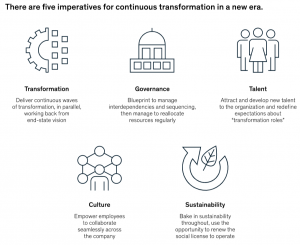Juggling chainsaws: Leading a multifaceted transformation

A leading Asia-Pacific (APAC) company forecasted that more than one-third of its EBITDA would disappear over the upcoming three years due to increased competition and changing customer behaviour, among other drivers. Its leadership team embarked on a transformation that drew on these five imperatives to rise to the challenge.
1. Strategy–back transformation model
Companies can benefit most by taking a future–back view of strategy, using the desired end state to set the transformation’s direction and aspiration. As we discussed earlier, this exercise can mean a fundamental rethinking of how the business serves its customers. It also means pulling levers in parallel, rather than sequentially, an approach that can significantly improve the odds of success. Executives will have to embrace the notion that the business will need to continually transform across multiple waves, which will constantly challenge the future state.
Example
The APAC company was no stranger to change; it had previously led an ambitious four-year digital transformation while reducing operating expenses by more than 20 percent. However, the competitive landscape had shifted, with most opportunities requiring a full reset of the business and its underlying economic model as well as speedier innovation.
The leadership team seized on the opportunity for reinvention. Over two months, a small group defined the future state and then worked backward to sketch out a vision. They faced difficult truths head-on, questioning long-held beliefs about differentiation, customer loyalty, and brand.
2. Strong transformation governance
Achieving change at scale across multiple levers requires a company to effectively manage not just their interdependencies but also multiple programmes. Some will be cross-functional in nature, requiring strong sequencing management and executive-level trade-offs; others will occur primarily within a given function; and still others will be dependent on outside stakeholders, such as M&A. As a result, companies will need to develop a clear blueprint at the outset to coordinate multiple streams and levers in parallel. For example, what are the interdependencies between streams? How should they be balanced to operate within the bounds of finite resources? What is the required sequencing to accelerate business impact?
As the transformation matures, this blueprint must be continually refreshed, with resources actively reallocated between streams. And governance is to be supported by a robust transformation office that has the ability to resolve issues as they arise and an executive with a transformation mandate. Ultimately, the line business needs to own and deliver the change, but the transformation office can ensure pace and orchestration and remove bottlenecks for critical issues. This team needs to have the execution muscle and agility to support ongoing waves of transformation.
Example
The company’s strategy–back approach led it to embark on a three-year transformation across multiple streams. Each programme worked in close collaboration with the others, ensuring that parallel changes were self-reinforcing. Moreover, each element was planned centrally in line with the end-state blueprint and associated guardrails, then designed and delivered with a mix of local and central orchestration. Critically, the blueprint was continually refined as the market evolved and plans took root.
3. New skill sets
Companies can benefit from preparing to both acquire and build capabilities in areas where bottlenecks arise. Addressing these bottlenecks will probably require newer capabilities given the increasing interface between technology and other parts of the business. Roles such as data-and-analytics translators are likely to become more crucial. Career paths need to be reshaped such that top performers flow to high-value opportunities. The allocation of high-potential employees to transformation roles can enable companies to further build the transformation muscle necessary to undertake multiple waves.
Example
The company knew that it must reset its approach to talent and ways of working to compete in emerging value pools. This objective meant both hiring new capabilities and building an operating model that could be successfully deployed within. It created a people-first model that ensured that there was a specific skill- and capability-development journey for each employee regardless of their role within the company.
4. Culture to support the desired change
A transformation is, at its core, a cultural intervention. Multilever waves of transformation are simply too big to be delivered purely from the centre, which creates a need to genuinely empower teams. Facing this degree of change without a sufficient change-management effort can lead organisations to experience a profound sense of dislocation. Successful companies possess a coherent vision that brings together all transformation streams and lays out the journey through the end state. This vision should translate to a clear narrative for employees, investors, and other stakeholders. The magnitude of change requires cross-company collaboration that goes beyond lip service. Teams will need to work across what were previously silos, with traditionally back-office functions such as legal or risk embedded in frontline teams and digital builds spanning business units.
Example
The core of the company’s cultural change was creating a radically flatter structure and implementing agile at scale. Previously, entrenched silos between “thinking work” and “doing work” led to slow decision making and time to market. The company embedded cross-organisation processes into its quarterly cycle. These interventions were successful in improving business outcomes and actually delivered exceptional improvement on organisational health over two years, moving from the bottom quartile to the second quartile.
5. Sustainability at the core
In any transformation, sustainability is best placed front and centre. In the current era, this goes beyond economic performance to embrace a broader view of societal and environmental impact. The importance of sustainability continues to grow as customer-buying behaviours shift and purpose becomes a key differentiator in the war for talent. Transformations offer a “moment in time” opportunity to renew and refresh the social license to operate.
Example
The company understood the importance of embedding sustainability into its strategy. Throughout the transformation, it led its industry in transitioning to become carbon neutral. When COVID-19 struck, it was proactive in shifting the trajectory of the transformation to help renew its social license to operate.
In 18 months, the company’s share price climbed 40 percent. Midway through a radical simplification, the organisation was more efficient and faster to market. Employees were happier, and its sustainability activities were lauded.





